
Carex flacca, with common names blue sedge, gray carex, glaucous sedge, or carnation-grass,, is a species of sedge native to parts of Europe and North Africa. It is frequent in a range of habitats, including grasslands, moorlands, exposed and disturbed soil, and the upper edges of salt marshes. It has naturalized in eastern North America.
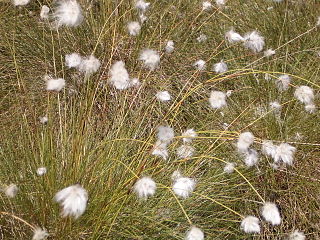
Eriophorum vaginatum, the hare's-tail cottongrass, tussock cottongrass, or sheathed cottonsedge, is a species of perennial herbaceous flowering plant in the sedge family Cyperaceae. It is native to bogs and other acidic wetlands throughout the Holarctic Kingdom. It is a 30–60 cm high tussock-forming plant with solitary spikes.
Carex arcta is a species of sedge known by the common name northern cluster sedge. It is native to northern North America including most of Canada and northern parts of the United States. It grows in wet areas, especially in coniferous forests. This sedge produces dense clumps of erect stems up to about 80 centimetres (31 in) high. The leaves are pale green to grayish, flat, and have reddish or purple-dotted sheaths at the base, and they are sometimes longer than the stems. The inflorescence is a dense, oblong cluster of up to 15 spikes of pointed flowers, each cluster up to 3–4 cm (1.2–1.6 in) long and each individual spike up to 1 cm (0.39 in) long. The fruit is covered in a sac called a perigynium which is greenish and veined with a reddish tip.
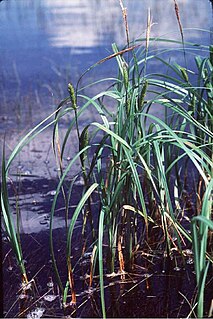
Carex atherodes is a species of sedge known by the common name wheat sedge. It is native to Eurasia and much of North America including most of Canada and the United States. It is a very common wetland plant across the American Midwest and areas west. It grows in moist and wet habitat, such as marshes and moist prairie land, and it may grow in shallow water. This sedge produces triangular, hollow stems 30 to 120 centimeters tall. The leaves are hairy, especially on the lower parts, and the leaf sheath is tinted with reddish purple. The inflorescence is up to 60 centimeters long and made up of several spikes; those spikes near the tip are usually staminate, and those lower in the inflorescence are usually pistillate. The tip of each fruit has two or more long, thin teeth.
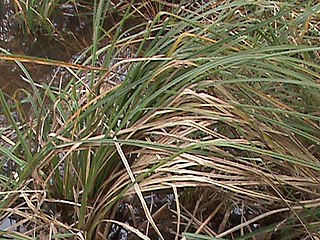
Carex barbarae is a species of sedge known as Santa Barbara sedge.

Carex diandra is a species of sedge known by the common names lesser tussock-sedge and lesser panicled sedge.
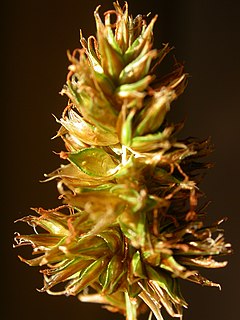
Carex hoodii is a species of sedge known by the common name Hood's sedge. It is native to western North America from Alaska to Nunavut to California to South Dakota, where it grows in dry to moist habitat in forests and on mountain slopes.

Carex leporinella is a species of sedge known by the common name Sierra hare sedge.
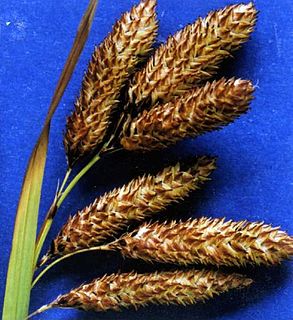
Carex mertensii is a species of sedge known by the common name Mertens' sedge. It is native to western North America from Alaska to California to Montana, where it grows in moist and wet habitat in mountain forests and meadows. This sedge produces clumps of stems reaching maximum heights between 80 and 120 centimeters. The leaves are small; those toward the bases of the stems are reduced to sheaths only. The inflorescence is a densely packed, bullet shaped cluster of overlapping flowers, mainly hanging on long peduncles. Each inflorescence is generally 2 to 4 centimeters long. Each of the flowers has a dark-colored bract.
Carex petasata is a species of sedge known by the common name Liddon sedge.

Carex praticola is a species of sedge known by the common name meadow sedge. It is native to most of northern North America, including most of Canada and the northernmost United States. It grows in many habitat types from wet to dry, including moist mountain meadows and woodlands. This sedge produces dense clumps of stems approaching a meter in maximum height. The inflorescence is an erect or nodding cluster of several flower spikes in color light greenish or brown to white. The fruit is covered in a perigynium which is white to cream, sometimes with a coppery center, and translucent.

Carex scoparia is a species of sedge known by the common names broom sedge and pointed broom sedge. It should not be confused with the unrelated grass species known as "broom sedge," Andropogon virginicus.

Carex pilulifera, the pill sedge, is a European species of sedge found in acid heaths, woods and grassland from Macaronesia to Scandinavia. It grows up to 30 cm (12 in) tall, with 2–4 female spikes and 1 male spike in an inflorescence. These stalks bend as the seeds ripen, and the seeds are collected and dispersed by ants of the species Myrmica ruginodis.

Carex concinna is a species of sedge known by the common names low northern sedge, northern elegant sedge, beauty sedge, and beautiful sedge. It is native to northern North America, where it occurs across Canada and in high elevations in the northern contiguous United States.

Carex sylvatica is a species of sedge found in deciduous woodlands across Europe. It typically reaches 60 cm (24 in) tall, and has an inflorescence made up of 3–5 pendent female spikes and a single male spike. It is also used as a garden plant, and has been introduced to North America and New Zealand.
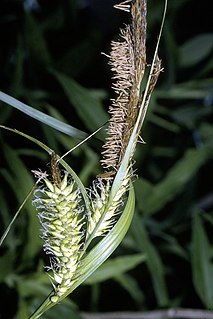
Carex lacustris, known as lake sedge, is a tufted grass-like perennial of the sedge family (Cyperaceae), native to southern Canada and the northern United States. C. lacustris us an herbaceous surface-piercing plant that grows in water up to 50 cm (1.6 ft) deep, and grows 50–150 cm (1.6–4.9 ft) tall. It grows well in marshes and swampy woods of the boreal forest, along river and lake shores, in ditches, marshes, swamps, and other wetland habitat. It grows on muck, sedge peat, wet sand or silt, in filtered or full sunlight.

Carex eburnea, known as ivory sedge, ebony sedge, and bristleleaf or bristle-leaved sedge, is a small and slender sedge native to North America, from Alaska and Newfoundland south to central Mexico.
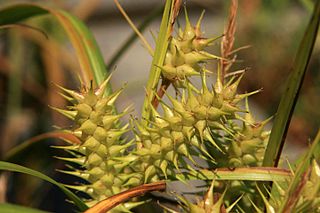
Carex lupuliformis, common name false hop sedge, is a perennial sedge of sporadic distribution found in the floodplain forests and ephemeral woodland ponds of central and eastern North America. The species typically produces four to seven leaves with sheaths of distal leaves of 3 to 21 cm whose ligules are rounded to triangular. Carex lupuliformis blooms between early June and early October, typically with "two to six proximal female spikes, distal spikes usually crowded, ascending, densely flowered, usually cylindric, much longer than broad; one to two terminal male spikes." Fruiting occurs between late July through early October. Fruit is described as "perigynia ascending to spreading, inflated, strongly veined, sessile, lance-ovoid, shiny, glabrous; beak conical; achenes stipitate, broadly diamond-shaped, scarcely if at all longer than wide, concave faces, angles thickened, prominently knobbed with hard, nipplelike points."

Trichophorum cespitosum, commonly known as deergrass or tufted bulrush, is a species of flowering plant in the sedge family. It was originally described by the Swedish naturalist Carl Linnaeus in 1753 as Scirpus cespitosus, but was transferred to the genus Trichophorum by the Swedish botanist Carl Johan Hartman in 1849, becoming Trichophorum cespitosum.

Schoenus compactus is a species of sedge endemic to south-western South Africa.


















